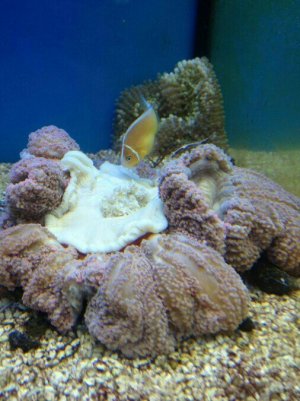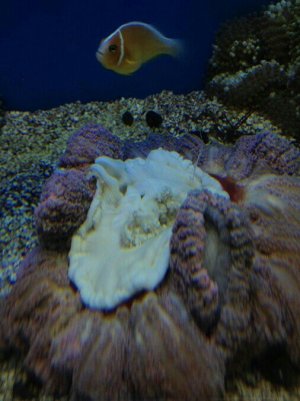You are using an out of date browser. It may not display this or other websites correctly.
You should upgrade or use an alternative browser.
You should upgrade or use an alternative browser.
Protocol for using antibiotics to treat infected anemones ~Added to 7/30/14
- Thread starter OrionN
- Start date
motojoe1988
Member
any other meds?
any other meds?
Im looking to pick up a gig today but cant get any cirpo for a few days. Can I use amoxicilan?
any other meds?
Im looking to pick up a gig today but cant get any cirpo for a few days. Can I use amoxicilan?
Hey y'all. new to the forum and have been back in the hobby for about 6 months now after about a 6 year hiatus. I just had two fish (blue damsel & clown fish) die. I QT'd them and treated them with Herbtana but to no avail. The symptoms were lethargy in both of them with sore like wounds on them. The Damsel died first then the clown a couple days later. Here's a weird note, I would do a 50% water change every other day and on the last water change within an hour the clown fish snapped out of it's lethargic state and back to it's normal feisty self. I thought cool! he's going to make it only to wake up the next morning to find him dead. there were no signs of ich whatsoever. i'm thinking the infection wasn't parasitic.
everything else in my display are good and show no signs of stress. ph is right down the middle, salinity is 1.024, nitrates are a tad high (5 ppm) but i'm working on that, bought the tank used and it had been severely neglected, nitrites and amm are 0. tank consists of 2 pj's, one dragon gobi and house cleaners (aka shrimp and snails).
yesterday i went out and bought another clown fish and anenomie. both seem to be doing fine although i did catch a bristle worm trying to steal the food i'd just given the anenomie but the anenomie won that round.
your thoughts?
everything else in my display are good and show no signs of stress. ph is right down the middle, salinity is 1.024, nitrates are a tad high (5 ppm) but i'm working on that, bought the tank used and it had been severely neglected, nitrites and amm are 0. tank consists of 2 pj's, one dragon gobi and house cleaners (aka shrimp and snails).
yesterday i went out and bought another clown fish and anenomie. both seem to be doing fine although i did catch a bristle worm trying to steal the food i'd just given the anenomie but the anenomie won that round.
your thoughts?
D-Nak
Active member
During treatment of a haddoni, is it wise to have a a container with sand for the nem to put it's foot into to make it feel more secure while in the treatment tank or just leave it bare bottom?
I've treated two red haddoni -- once with sand (in a plastic container a bit larger than the nem) and once without -- and both ended with the death of the anemone. On the other hand I've treated a few gigantea, all with success.
I was told the first time around that the bacteria present on the sand may have died when Cipro was added, and this may have fouled the tank, so the second time I didn't use any substrate. The first haddoni never attempted to bury its foot, and the second never tried to attach to the tank. This is in contrast to all of the gigs, which quickly attached to either the tank bottom or rock (in one case it was already attached to a rock when I received it, and it never detached).
Both haddoni never showed a positive response to the Cipro treatment, only a quick decline. Again, this is in contrast to gigs, which all showed an immediate improvement.
If there are any other haddoni owners who have successfully treated with Cipro, I'm curious to know what the experience was like. In my cases, I started to think that for some reason, Cipro isn't as effective on haddoni as it is with gigantea, but there are too many factors -- and not enough testing to support my hypothesis -- that this is actually the case.
D-Nak
Active member
To far gone to treat? It just came in and was stressed was fine then this happened...
Thanks orion! I'll start working with it tonight!
Update? Did the nem make it?
Reef1589
Anemones for life
If there are any other haddoni owners who have successfully treated with Cipro, I'm curious to know what the experience was like. In my cases, I started to think that for some reason, Cipro isn't as effective on haddoni as it is with gigantea, but there are too many factors -- and not enough testing to support my hypothesis -- that this is actually the case.
Ive treated Mostly S. Gig's and my latest addition was my red haddoni, I treated it and saw rather quick improvements, not as quick as most of my S. Gig's, but non the less improvements within 24 hrs of treatment..
Picture at the LFS
nearly 24 hr laters in treatment tank..
<a href="http://s1113.photobucket.com/user/Reef1589/media/r2-1.jpg.html" target="_blank"><img src="http://i1113.photobucket.com/albums/k507/Reef1589/r2-1.jpg" border="0" alt=" photo r2-1.jpg"/></a>
<a href="http://s1113.photobucket.com/user/Reef1589/media/r1-1.jpg.html" target="_blank"><img src="http://i1113.photobucket.com/albums/k507/Reef1589/r1-1.jpg" border="0" alt=" photo r1-1.jpg"/></a>
It took about 3 weeks for his mouth to fully close tightly tho..
I know ive said this before in my S. Gig thread and on any of my treatment threads, I use different medication then Cipro, I use Levoflaxocin, which from my understanding talking to minh, is the Updated version of Cipro and tends to cost a tad bit more...
Thread is here with all my anemone's
http://www.reefcentral.com/forums/showthread.php?t=2276752
maddmaxx
New member
orionN couple questions sir...
if i have a 20L laying around, obviously i could use that as a HT..if i was to fill it all the way up during treatment and did a 50% water change, would i use 2 tablets after the water change?
also would a 4x T5 lighting fixture be enough for a s.mag?
if i have a 20L laying around, obviously i could use that as a HT..if i was to fill it all the way up during treatment and did a 50% water change, would i use 2 tablets after the water change?
also would a 4x T5 lighting fixture be enough for a s.mag?
OrionN
Moved on
I would dose 25mg/gal gal every day, so if your treatment tank is 20 gal then I would dose 500 mg. I think if you have fairly good lighting, the ciprofloxacin would breakdown with light so I assume that by the end of the day, you level is much lower if not all gone.
When my anemone is not doing well, I do 100% water change, I would still dose 25mg/gal. Right now I am treating two Gigantea in my HT, 20 gal high 50% fill. 1st day, last night, I change 100% of the water. Today, I will change only 50% of the water. They are doing much better. Last night I dosed 250 mg and will dose 250 mg today also. I have a 40 W flood LED 10,000K light on this tank. It is really bright with this LED.
When my anemone is not doing well, I do 100% water change, I would still dose 25mg/gal. Right now I am treating two Gigantea in my HT, 20 gal high 50% fill. 1st day, last night, I change 100% of the water. Today, I will change only 50% of the water. They are doing much better. Last night I dosed 250 mg and will dose 250 mg today also. I have a 40 W flood LED 10,000K light on this tank. It is really bright with this LED.
OrionN
Moved on
maddmaxx,
IMO, lighting is important. Without it, your sick anemone will loose all his zooxanthealle and after treatment he will be that much more difficult to bring back. Really bright light is not essential but enough light (more is better IMO unless it cause temp instability) so that the anemone will not loose all of his zooxanthallae. Your light should be fine. As long as there are zooxanthallae still in the anemone, they will repopulate the tissue easy enough.
It is unlikely that the light will help anemone produce enough calorie to sustain himself especially with infection and injury. Since they are not eating with treatment, anything help.
IMO, lighting is important. Without it, your sick anemone will loose all his zooxanthealle and after treatment he will be that much more difficult to bring back. Really bright light is not essential but enough light (more is better IMO unless it cause temp instability) so that the anemone will not loose all of his zooxanthallae. Your light should be fine. As long as there are zooxanthallae still in the anemone, they will repopulate the tissue easy enough.
It is unlikely that the light will help anemone produce enough calorie to sustain himself especially with infection and injury. Since they are not eating with treatment, anything help.
OrionN
Moved on
Another thread on treating newly import S. gigantea with Cipro. My Petco Gigantea (5 total)
http://reefcentral.com/forums/showthread.php?t=2329256
http://reefcentral.com/forums/showthread.php?t=2329256
Brando5185
New member
Is cipronatin the same? I ordered ciprofloxacin and they sent cipronatin.
this is me
Active member
I'm planning on doing this treatment when I acquire a gigantea. What kind of light during the treatment process? Does it need to be strong MH light during the treatment? Wouldn't the strong light makes the cipro dissolve too fast and not give it enough time to treat the infection?
Similar threads
- Replies
- 6
- Views
- 1K




